May 1 - 7 2016: Issue 261
ORTHODOX EASTER
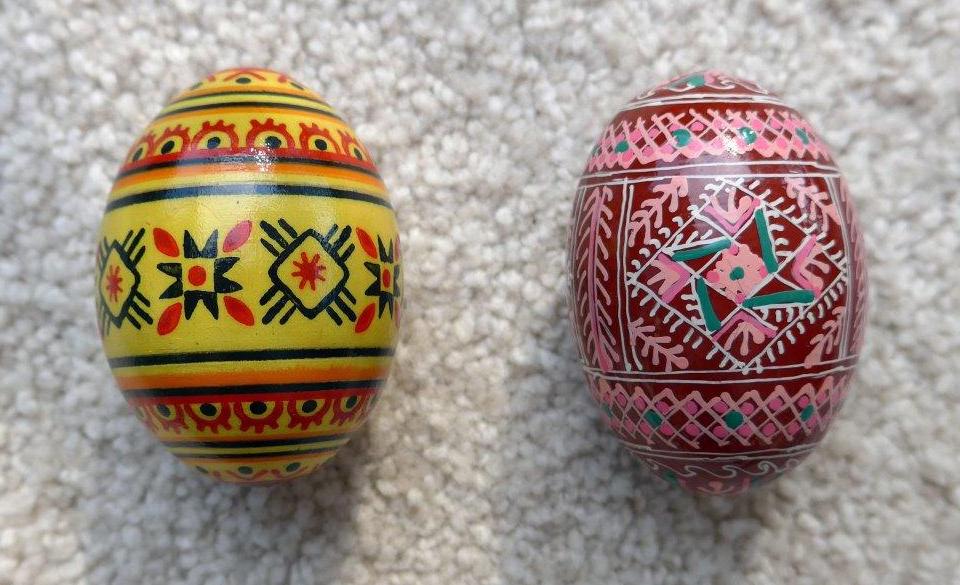
Ukrainian style decorated Easter eggs
ORTHODOX EASTER
By George Repin
This year, for members of Orthodox churches in twenty-four countries, Easter Sunday will be on May 1. Believers will flock to churches in countries such as Russia, Greece, the Ukraine, Cyprus and Bulgaria to demonstrate their faith in the Resurrection of Jesus.
THE RUSSIAN ORTHODOX EASTER
Of all holidays celebrated by Russians the most significant, deeply rooted in the Slavic past, is Easter – the principal feast day of the Orthodox calendar. At Easter Russians throughout the world share a tradition which leads them to crowd Orthodox churches and cathedrals, whether in Paris, New York, San Francisco or even Sydney.
In the 1930s and early 1940s when there was no Russian Orthodox Cathedral in Sydney the need for a church large enough to accommodate the many wishing to attend the Easter service led to the adoption of Christ Church of St. Laurence in George Street, near Railway Square for the purpose and its use continued until the Sts. Peter and Paul Cathedral was built in Vernon Street, Strathfield.
The Easter service broadly follows a pattern starting at about 11 pm on Easter Saturday with prayers and unaccompanied church choir singing as the congregation gathers – all standing and each person holding a lighted candle (often of beeswax). As midnight approaches the church is full to overflowing, with people standing outside. Just before midnight all lights are turned off and candles extinguished while the congregation waits for midnight when bells ring out and the priest repeatedly intones the words: Xpuctoc Bockpec (“Christ is risen”) to which the congregation responds (in Russian) “Truly He is risen”. Priests start relighting candles from the front of the church.
(The exchange “Christ is risen” and the response “Truly He is risen” is the traditional greeting when people meet through the Easter period.)
During the next two hours or so, as the service continues, people gradually drift off to their homes where the feast they laid out before going to church, awaits them - including zaskuski, piroshki and vodka.
Always there are boiled eggs, coloured and sometimes decorated, Kulich and Paskha. The Kulich and Paskha always bear the Russian letters X B denoting that Christ is risen.
Kulich is a sweet yeast-risen Russian Easter bread – really a cross between a bread and a cake – baked in tall cylindrical tins – usually with nuts, raisins and candied citrus peel – sometimes with a touch of saffron. It is decorated with white icing which drizzles down the sides and the Russian letters XB on top.
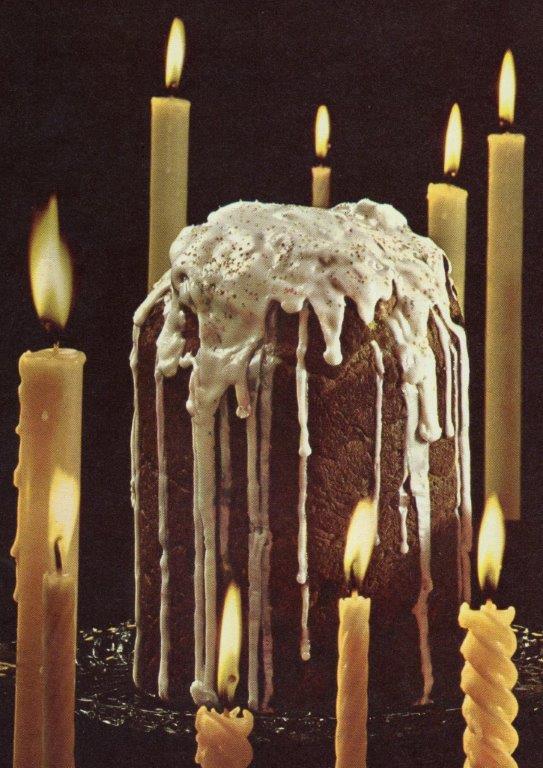
Easter - Kulich
Paskha is a traditional sweet Easter dish made from tvorog (farmers’ cheese/curd cheese), butter, eggs, heavy or sour cream, raisins, almonds, vanilla, spices and candied fruits. It is moulded into a truncated pyramid and decorated with XB.
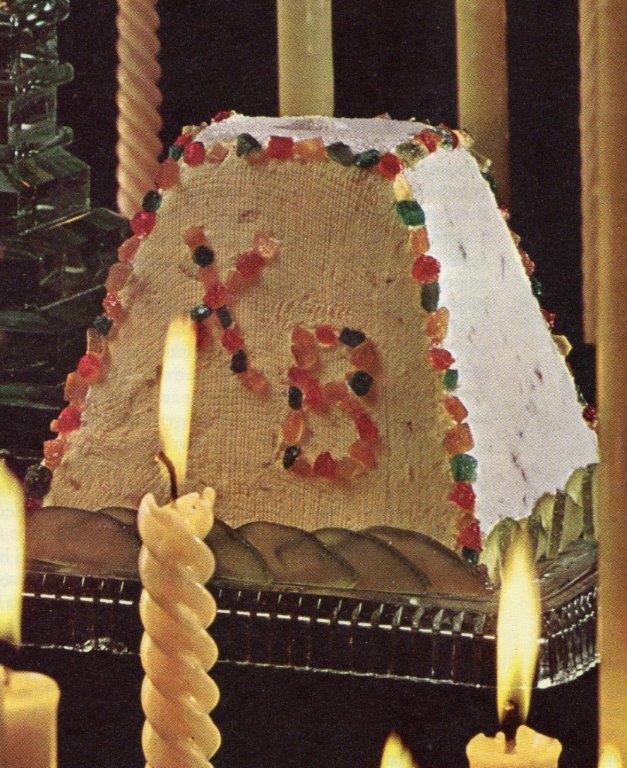
Easter - Paskha
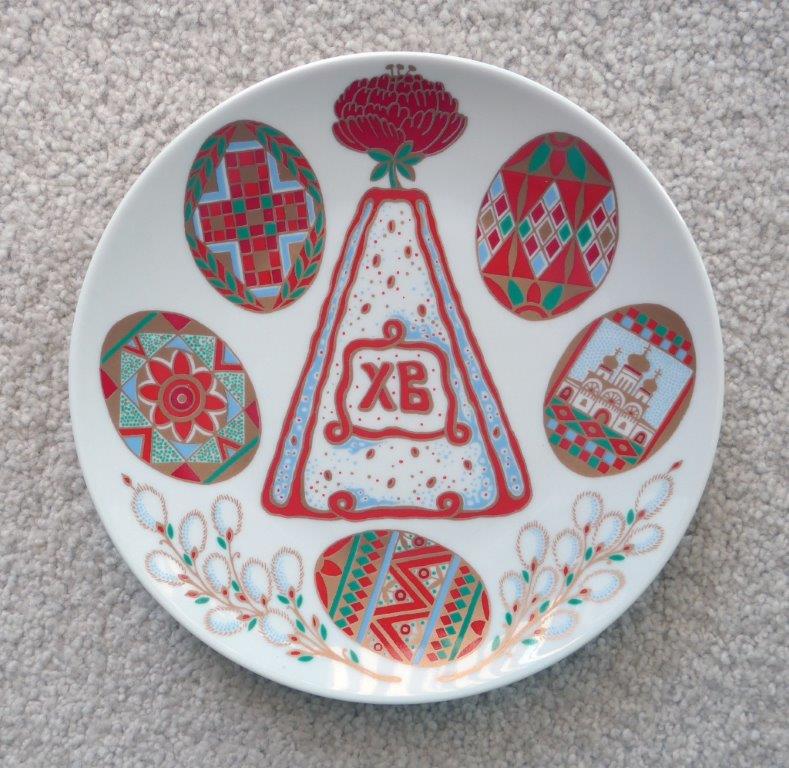
Hand decorated Easter Plate - bought in St. Petersburg 2005
DETERMINATION OF THE DATE OF EASTER
In Orthodox churches the date of Easter varies from year to year as does the date in Western churches – but there is no obvious relationship between the dates to explain the differences. Occasionally the dates coincide.
Arriving at an agreed basis for setting the date for Easter has been the subject of debate from the early centuries of Christianity. As the crucifixion occurred after the Hebrew Passover the Hebrew calendar, for a time, was a reference point but over time was deemed inappropriate.
The ecclesiastical rules that determine the date of Easter trace back to the First Council of Nicaea (325 CE) convened by the Emperor Constantine at a time when the Roman world used the Julian Calendar.
Tables were constructed to compute the date, and over the years underwent modifications. In 1582 a reconstruction of the Julian Calendar produced new Easter tables. By the 1700s this new calendar, the Gregorian Calendar, was adopted in most of Western Europe.
However the Eastern Christian churches still determine the date of Easter using the Julian Calendar method.
The statement that Easter Day is the first Sunday after the full moon that occurs next after the vernal equinox is only an approximate statement of the actual ecclesiastical rules. The full moon involved is not the astronomical full moon but an ecclesiastical moon (determined from tables).
The ecclesiastical rules are:
• The vernal equinox is on March 21,
• The ecclesiastical full moon is on the 14th day of a tabular new moon, and
• Easter is on the first Sunday following the first ecclesiastical full moon that occurs on or after the day of the vernal equinox.
There are other complications - and in recent times there have been attempts to change the method or even to agree a date to apply each year (like Christmas). This is an interesting topic which anyone who is particularly interested can pursue.
To sum up: The civil date of Easter depends on which tables are used – Gregorian or pre-Gregorian (i.e. older tables based on the Julian Calendar).
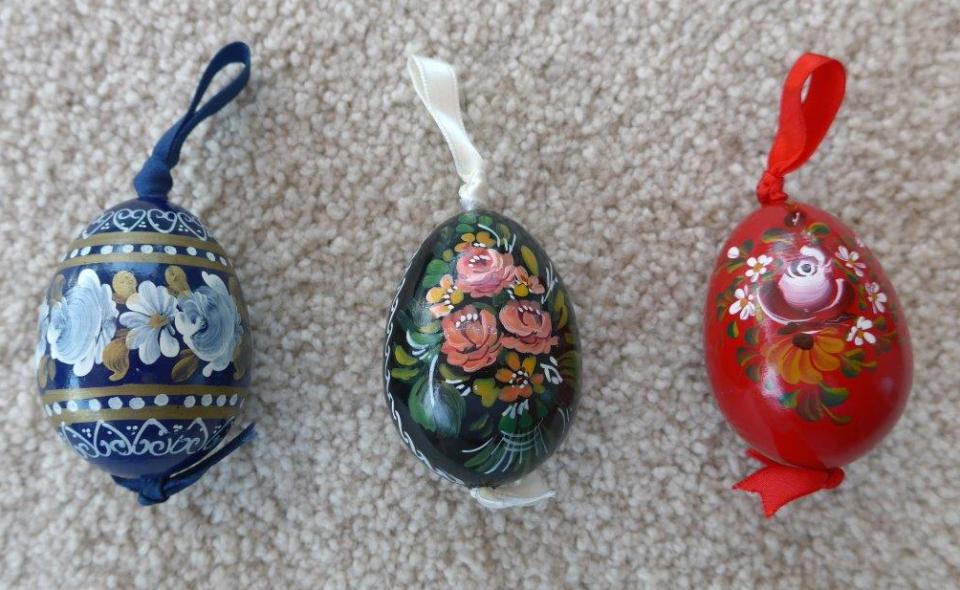
Easter eggs hand decorated by an artist
Previous Reflections by George Repin
The Nineteen Thirties Remembering Rowe Street The Sydney Push Saturday Night at the Movies Shooting Through Like A Bondi Tram A Stop On The Road To Canberra City Department Stores - Gone and Mostly Forgotten An Australian Icon - thanks to Billy Hughes Crossing The Pacific in the 1930s Hill End The Paragon at Katoomba Seafood In Sydney How Far From Sydney? Cockatoo Island Over The Years The Seagull at the Melbourne Festival in 1991 Busby's Bore The Trocadero In Sydney Cahill's restaurants Medical Pioneers in Australian Wine Making Pedal Power and the Royal Flying Doctor Service Pambula and the Charles Darwin Connection Gloucester and the Barrington Tops A Millenium Apart Have You Stopped to Look? Gulgong Il Porcellino Olympia Durham Hall Sargent's Tea Rooms Pie Shops and Street Photographers The Ballet Russes and Their Friends in Australia Hotels at Bondi Alma Ata Conference - 1978 Keukenhof - 1954 The Lands Department Building and Yellowblock Sandstone The Goroka Show - 1958 A Gem On The Quay Staffa The Matson Line and Keepsake Menus Kokeshi Dolls The Coal Mine At Balmain The Hyde Park Barracks The Changing Faces Of Sydney From Pounds and Pence to Dollars and Cents Nell Tritton and Alexander Kerensky Making A Difference In Ethiopia William Balmain J C Bendrodt and Princes Restaurant Azzalin Orlando Romano and Romano's Restaurant Waldheim Alcohol in Restaurants Before 1955 King Island Kelp The Mercury Theatre Around Angkor - 1963 Angkor Wat 1963 Costumes From the Ballets Russe Clifton at Kirribilli Chairman Mao's Personal Physician The Toby Tavern The MoKa at Kings Cross The Oceaographic Museum in Monaco The Island of Elba Russian Fairy Tale Plates Meteora Souda Bay War Cemetery Barrow, Alaska Cloisonné Tripitaka Koreana Minshuku The Third Man Photographs and Memories Not A Chagall! Did You Listen? Did You Ask? Napier (Ahuriri, Maori) New Zealand Borobudur Ggantija Temples Plumes and Pearlshells Murano University of Padua Ancient Puebloe Peoples - The Anasazi Pula The Gondolas of Venice Cinque Terre Visiting the Iban David The Living Desert Bryce Canyon National Park Aphrodisias The Divine Comedy Caodaism Sapa and local Hill People A Few Children Cappadocia Symi Jean-Marie Tjibaou Cultural Centre Aboriginal Rock Art on Bigge Island ANZAC Cove (Ari Burnu) 25 April, 1997 Hotere Garden Oputae Children of the Trobriand Islands Page Park Market - Rabaul Rabual Kotor, Montenegro Galleries of Photographs I Lascaux Galleries of Photographs II The Cathedral of St. James – Šibenik, Croatia Ivan Meštrović - Sculptor Delphi Gallery of Photographs III The Handicrafts of Chiang Mai Raft Point San Simeon - "Hearst Castle" Floriade - The Netherlands - 1982 Russian New Year Mycenae "Flightseeing" Out Of Anchorage Alaska The White Pass and Yukon Route Totem Poles Tivkin Cemetery Krka National Park - Croatia Tavistock Square and the BMA
Copyright George Repin 2016. All Rights Reserved.